Douglas Havelock Newman was born and grew up in Chelmsford. He worked at Hoffmann’s bearings factory in the town. He joined the army in December 1915, was mobilized the following March and in December 1916 transferred regiments. He was taken prisoner of war in April 1917 at Monchy-le-Preux. He was freed at the end of the war and left the army in August 1919. His health, however, had been broken during his time as a prisoner, and although he was well enough to marry in October 1919 he died in Great Baddow in June 1921. His parents lived in South Primrose Hill. A cousin was killed during the war.
NEWMAN, DOUGLAS HAVELOCK,
Lance Corporal, 1st Battalion, Essex Regiment (formerly of Essex Yeomanry)
Essex Yeomanry, afterwards being transferred to the 1st Essex Regt. for service in France. He took part in the great battle of Monchy, April 14, 1917, and was reported missing when the regiment suffered so severely. nothing was heard of him until the following October, when he was found to be a prisoner of war. He was released in January, 1919, and since that time his health had caused some anxiety owing to his terrible privation experienced while behind the enemy lines in France. He kept at work until January of this year, when he had a complete nervous breakdown. The end came rather suddenly, deceased having been confined to bed for only one day. He leaves a widow with whom much sympathy is felt. The funeral will take place at Great Baddow Churchyard to-day (Friday) at two o’clock.”
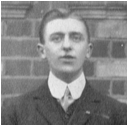
Douglas was born on 24th July 1893 in Chelmsford, the eldest son of the printer Alexander Dixon Newman and Esther Newman (nee Ely). His father had been born in Chelmsford in 1867; his mother in 1868 in Hatfield Broad Oak. The couple had married in Chelmsford in 1892.
Douglas’ two siblings (both Chelmsford-born) included Stanley Wilfred Newman (born in 1895, died in 1955) and Harold Claude Newman (born in 1901, died in 1964).
The 1901 census found seven year-old Douglas living with his parents and two siblings at 5 West End Terrace, South Primrose Hill, Chelmsford. His
father was a printer at the Essex Weekly News. The property is now number 99, having been numbered 41, then 29 in the intervening period (pictured).
The photograph above shows Douglas around 1910. The following year the 1911 census recorded 17 year-old Douglas living with his parents, two brothers and a London-born cousin, Florence Rosa Bushell, at ‘29 West End Terrace, South Primrose Hill’. Douglas was a cashier’s clerk at Hoffmann’s ball-bearings factory in Chelmsford; his father was printer’s machine minder at a newspaper and general printers; while his brother Stanley was a junior clerk for a coal merchant.
The 1914-15 register of electors listed Douglas’ father at 41 South Primrose Hill.
On 23rd April 1914 Douglas was photographed at Chelmsford Cathedral with colleagues from the Cathedral’s Guild of Change-Ringers. Amongst them was his paternal grandfather William Newman (see photograph below).
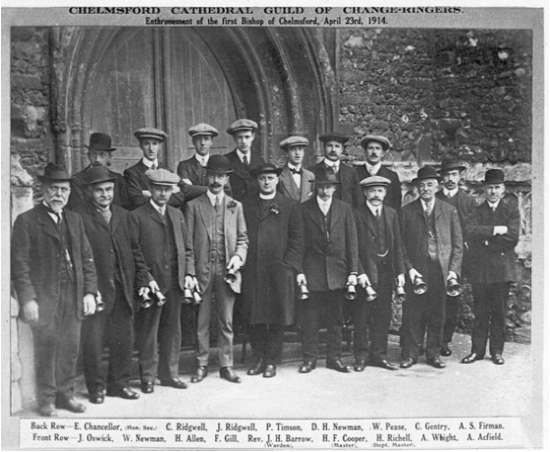
On 7th December 1915 Douglas attested at Chelmsford for short service (‘for the duration of the war, with the Colours and in the Army Reserve’). At the time he was 22 years and five months old, resident at 41 South Primrose Hill, and employed as a clerk at Hoffmann’s. He was single with no previous military service. He was also medically examined at Chelmsford and described as of good physical development, weighed 114 pounds, was five feet five and a half inches tall with an expanded chest of 33 and a half inches. His father, of the same address, was his next of kin and he was a member of the Church of England.

On 31st March 1916 Douglas was mobilized from the army reserve and appointed as Trooper 2668 in the 3/1 Essex Yeomanry at Colchester. On 19th May 1916 he was admitted to Cambridge Hospital in Aldershot, Hampshire suffering from a ‘wound of toe nail’ for which he ‘was not to blame’ after apparently being trod on by a horse the previous day when grooming the horse at stables at West Cavalry Barracks. At the time he was in A Squadron of the 3/1st Essex Yeomanry, attached to the 2nd Cavalry Reserve. He remained in hospital until 6th July 1916.
Douglas was one of a large number of men transferred from 3/1st Battalion of the Essex Yeomanry to the Essex Regiment in December 1916 - others included Arthur Saltmarsh and Robert Acfield Gibbons, both of who are commemorated at Chelmsford. Douglas crossed from Folkestone, Kent and landed in Boulogne France on 29th December 1916. He joined the 1st Battalion of the Essex Regiment in the field on 13th January 1917 where he served as Private 34178. He was appointed Lance Corporal on 7th April 1917.
On 14th April 1917 Douglas’ battalion, along with the Newfoundland Regiment, attacked German positions on Infantry Hill near Monchy-le-Preux, a village nine kilometres ears of Arras. Although the Germans were initially pushed back, they counter-attacked and inflicted very heavy casualties on Douglas’ battalion - it had gone into action with 31 officers and 892 other ranks, of whom at the end of the day 17 officers and and 644 ranks were either, killed, wounded or missing. The missing included 203 who were taken prisoner, one of whom was Douglas, though there was to be no news of him for some months. His father was informed of his loss on 20th April 1917.
On 29th June 1917 the Essex Weekly News reported:
“Mr. and Mrs. A. Newman, of 41, South Primrose Hill, Chelmsford, would be glad to receive any information from comrades of their eldest son, Lc.-Corpl. D. H. Newman, Essex Regt., late Yeomanry, who has been missing in France since April 14.”
On August 3rd 1917 the Essex Weekly News reported:
“Mr. and Mrs. A. Newman, 41, South Primrose-hill, Chelmsford, have this week received official notice that their son, Lance-Corpl. D. H. Newman, Essex Regt. (late Yeomanry), is a prisoner of war at Limburg, having been captured at Monchy on April 14, 1917. D. Newman before joining up was engaged on the staff at Hoffmann’s, and was a member of the Cathedral band of bell ringers. Mr. and Mrs. Newman’s second son is still serving in Palestine.”
On 12th October 1917 the Essex County Chronicle reported:
“Mr. and Mrs. Newman, 41 South Primrose Hill, Chelmsford have received a postcard from their son, Lance-Corpl. D. H. Newman, Essex Regt., who was taken prisoner on April 14, 1917, by the Germans, stating that he is quite well, and in Kriegsgefangenen, Stammlager, Germany.”
A similar report appeared in the day’s Essex Weekly News:
“Mr. and Mrs. Newman, 41, South Primrose-hill, Chelmsford, have this week received a postcard from their son. Lance-Corpl. D. H. Newman, Essex Regt., who was taken prisoner on April 14th, 1917. stating that he is quite well and is at Stammlager. Germany. This is the first communication received from the Lance-Corporal since he was reported missing, although official intimation had been given that he was in the hands of the Germans.”
Douglas’ cousin Archibald Alexander Ely was killed in action on 29th March 1918 and is commemorated on the Civic Centre Memorial, Chelmsford.
The photograph opposite, top shows Douglas pictured whilst a prisoner of war in Germany.
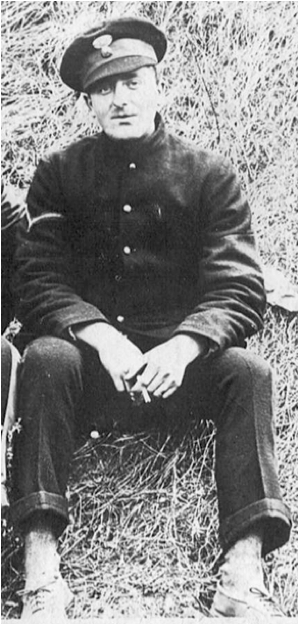
The 1918 register of electors listed Douglas’ parents still at 41 South Primrose Hill (today renumbered as 99).
Douglas was released from being a prisoner of war and posted back to Warley in January 1919. After two months’ leave he began work at the army record office at Warley until his demobilisation in August 1919. On 20th August 1919 he signed a certificate stating that at the time he did not claim to be suffering from a disability due to his military service.
Later that year, on 11th October 1919, Douglas married Elizabeth Linsell at St. John’s Church, Moulsham. By then Douglas was 26 years old, employed as a clerk, and lived at 41 South Primrose Hill. His bride was the 28 year-old, East Ham-born, elder daughter of John Linsell, a hammer-man. She lived at 96 Baddow Road, Chelmsford (later renumbered 133 Baddow Road) and in 1911 had been a typist at Hoffmann’s ball-bearings factory, where presumably she had met Douglas.
Douglas was entitled to the British War Medal and Victory Medal. He acknowledged receipt of the former on 11th December 1920 and the latter on 18th June 1921. However, by then his health was in decline.
Douglas died, aged 28, on 7th May 1922 at New Road in Great Baddow. His death was covered by the Essex Weekly News five days later:
“Victim of war service. - The death of Mr. Douglas H. Newman, eldest son of Mr. & Mrs. A Newman, 41, South Primrose-hill, Chelmsford, took place at his residence, New-rd, Great Baddow, on Sunday. Deceased, who was 28 years of age, had been employed on the staff of Hoffmann’s Ltd., for 13 years, and was much respected. During the war he volunteered under the Derby scheme and joined the
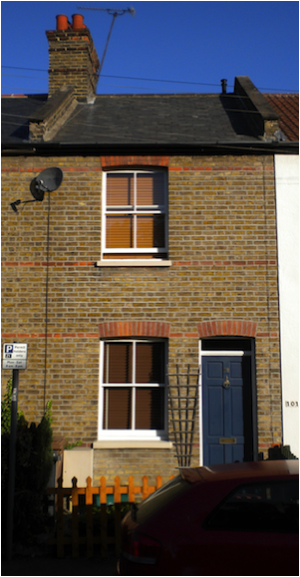
The paper also included a death notice:
“Newman. - On May 7, at New-road Great Baddow, Douglas H. Newman, eldest son of Mr. and Mrs. A. Newman, Primrose-hill, Chelmsford, aged 28 years.”
That week’s Essex Chronicle also included an identical family announcement and a similar report on Douglas’ death:
“War Tragedy. - We regret to record the death of Mr. Douglas H. Newman, aged 28, son of Mr. and Mrs. A. Newman of 41 South Primrose Hill, which took place at his residence, New Road, Great Baddow, on Sunday. The deceased, who was well known and highly respected, had been employed on the staff of Messrs. Hoffmann’s for about 12 years, when he left early in the war to join the Army under the Derby Scheme, and became attached to the Essex Yeomanry. Afterwards he was transferred to the 1st Essex regt. for service in France. He took part in the battle of Monchy, and was afterwards reported missing, and nothing was heard of him for about six months, when he was found to be a prisoner of war in Germany. He was released in January 1919, since when his health, which had been affected by his terrible experiences during the time he was prisoner of war, caused considerable anxiety, He went back to Messrs. Hoffmann’s, and kept at work until January this year, when he had a complete nervous collapse. He kept about for some time, and had only been confined to his bed the day previous to his death. he leaves a young widow, with whom great sympathy will be felt. The funeral takes place to-day (Friday) at Great Baddow Churchyard at 3 o’ clock.”
On 21st May 1922 Douglas’ widow wrote to the army from 96 Baddow Road, Chelmsford (later renumbered as 133):
“Dear Sirs, Could I please trouble you to send me a copy of my husband’s Demobilization papers, as he passed away about a fortnight ago, I am unable to get hold of his papers, They have been mislaid somewhere. His name and number is as follows: - L/Cpl. D. H. Newman. 1st Essex Regt.”
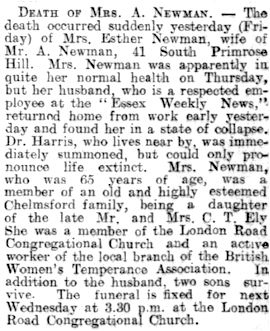
On 26th May 1922 the Infantry Record Office at Warley replied:
“Madam, I am in receipt of your letter of the 21st. inst., relative to your late husband, No. 34178, Pte. [sic] D. H. Newman, Essex Regiment, and in reply regret to inform you that existing regulations do not permit of a copy of his Demobilization Certificate being issued.”
Douglas is commemorated on the Civic Centre Memorial, Chelmsford, which records his regiment as the Essex Yeomanry. He is not commemorated on the Essex Yeomanry War Memorial or Hoffmann Memorial at Chelmsford Cathedral. Nor is he commemorated by the Commonwealth War Graves Commission, which does not recognise for commemorative purposes First World War deaths after 31st August 1921.
Douglas’ brother Stanley served in the 88th Field Ambulance, R.A.M.C. in Gallipoli. His mother died in 1934, aged 65; his father followed on 30th January 1954.
Douglas was one of the ‘South Primrose Hill Boys’.
131202
Acknowledgements to Ian Miller